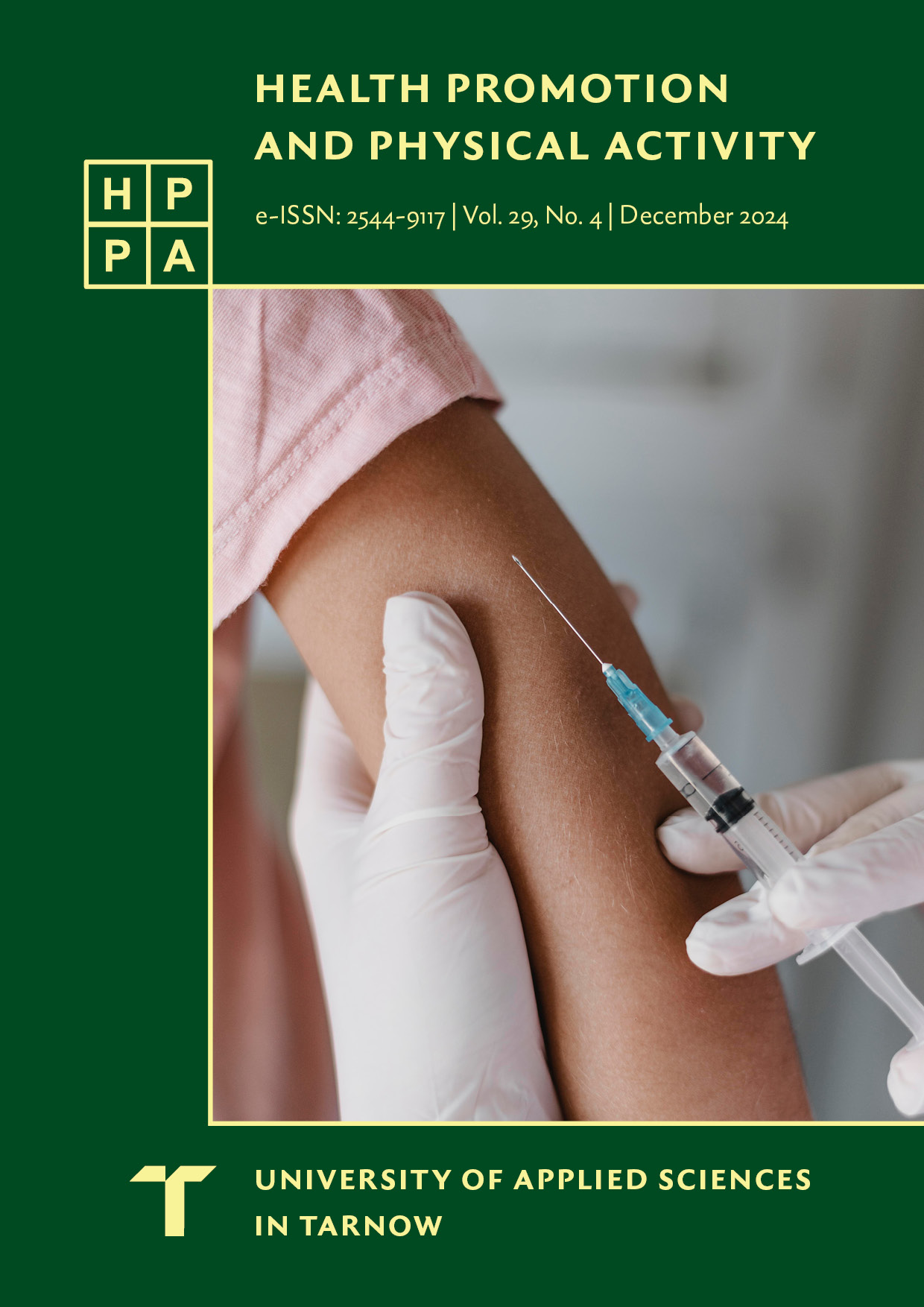Assessment of selected upper limb ranges of motion in violinists during instrument performance
DOI:
https://doi.org/10.55225/hppa.620Keywords:
Angulus application, goniometric measurements, violinist occupational biomechanics, ADL activitiesAbstract
Objective: Playing an instrument is a significant part of a violinist’s life. Daily, they are exposed to specific, forced positions of the upper limbs while playing. Any injuries or overloading of the musculoskeletal system can adversely affect their ability to perform their profession or pursue their passion for playing the violin. The aim of this study was to determine the ranges of motion of selected upper limb joints in violinists during violin playing. A deeper understanding of the biomechanics of playing the instrument can contribute to the development of increasingly effective rehabilitation protocols, facilitate preventive measures, and support the maintenance of musicians’ health and well-being.
Material and methods: Twenty-two violinists were recorded while performing a three-octave G-major scale. After selecting appropriate frames, an assessment of selected ranges of motion was conducted using the Angulus application.
Results: The ranges of motion achieved by violinists largely depend on their adopted playing technique. The greatest range of motion amplitude was observed in the sagittal plane in the shoulder joint and wrist joint of the bow-holding upper limb, as well as in the sagittal plane of the wrist joint of the violin-holding upper limb. The smallest ranges of motion were observed in the horizontal plane of the shoulder joint of the bow-holding upper limb and in the sagittal plane of the shoulder joint of the violin-holding upper limb.
Conclusions: Violinists work on average within the following ranges of motion: in the shoulder joint of the bow-holding upper limb: S: 0-15-87, F: 74-19-0, T: 0-47-63; in the elbow joint: S: 0-39-95; in the wrist joint: S: 34-0-35, F: 19-0-2. For the violin-holding upper limb, the ranges were: in the shoulder joint: S: 0-31-38, F: 22-6-0; in the elbow joint: S: 0-96-106; in the wrist joint: S: 17-0-25.
Downloads
References
Janiszewski M. Ergonomia zawodu muzyka. Analiza obciążeń i przeciążeń zawodowych muzyków. Warszawa–Łódź: Wydawnictwo Naukowe PWN; 1992. Google Scholar
Tubiana R, Amadio PC, eds. Medical Problems of the Instrumentalist Musician. London: Martin Dunitz; 2000. DOI: https://doi.org/10.1201/b14694 Google Scholar
Bejjani FJ, Kaye GM, Benham M. Musculoskeletal and neuromuscular conditions of instrumental musicians. Arch Phys Med Rehabil. 1996;77(4):406-413. doi: 10.1016/s0003-9993(96)90093-3. DOI: https://doi.org/10.1016/S0003-9993(96)90093-3 Google Scholar
Stanhope J. Physical performance and musculoskeletal disorders: Are musicians and sportspeople on a level playing field? Perform Enhanc Health. 2016;4(1-2):18-26. doi: 10.1016/j.peh.2015.11.004. DOI: https://doi.org/10.1016/j.peh.2015.11.004 Google Scholar
Konczak J, vander Velden H, Jaeger L. Learning to play the violin: Motor control by freezing, not freeing degrees of freedom. J Mot Behav. 2009;41(3):243-252. doi: 10.3200/JMBR.41.3.243-252. DOI: https://doi.org/10.3200/JMBR.41.3.243-252 Google Scholar
Lee H-S, Park HY, Yoon JO, et al. Musicians’ medicine: musculoskeletal problems in string players. Clin Orthop Surg. 2013;5(3):155-160. doi: 10.4055/cios.2013.5.3.155. DOI: https://doi.org/10.4055/cios.2013.5.3.155 Google Scholar
Schlaug G. Musicians and music making as a model for the study of brain plasticity. Prog Brain Res. 2015;217:37-55. doi: 10.1016/bs.pbr.2014.11.020. DOI: https://doi.org/10.1016/bs.pbr.2014.11.020 Google Scholar
Kava KS, Larson CA, Stiller CH, Maher SF. Trunk endurance exercise and the effect on instrumental performance: A preliminary study comparing Pilates exercise and a trunk and proximal upper extremity endurance exercise program. Music Perform Res. 2010;3(1):1-30. Google Scholar
Mizrahi J. Neuro-mechanical aspects of playing-related mobility disorders in orchestra violinists and upper strings players: a review. Eur J Transl Myol. 2020;30(3):9095. doi: 10.4081/ejtm.2020.9095. DOI: https://doi.org/10.4081/ejtm.2020.9095 Google Scholar
Yang N, Fufa DT, Wolff AL. A musician-centered approach to management of performance-related upper musculoskeletal injuries. J Hand Ther. 2021;34(2):208-216. doi: 10.1016/j.jht.2021.04.006. DOI: https://doi.org/10.1016/j.jht.2021.04.006 Google Scholar
de Souza Moraes GF, Antunes AP. Musculoskeletal disorders in professional violinists and violists: Systematic review. Acta Ortop Bras. 2012;20:43-47. doi: 10.1590/S1413-78522012000100009. DOI: https://doi.org/10.1590/S1413-78522012000100009 Google Scholar
Islan M, Blaya F, Pedro PS, D’Amato R, Urquijo EL, Juanes JA. Analysis and fem simulation methodology of dynamic behavior of human rotator cuff in repetitive routines: Musician case study. J Med Syst. 2018;42(3):55. doi: 10.1007/s10916-018-0908-7. DOI: https://doi.org/10.1007/s10916-018-0908-7 Google Scholar
Rietveld AB. Dancers’ and musicians’ injuries. Clin Rheumatol. 2013;32(4):425-434. doi: 10.1007/s10067-013-2184-8. DOI: https://doi.org/10.1007/s10067-013-2184-8 Google Scholar
Walmsley CP, Williams SA, Grisbrook T, Elliott C, Imms C, Campbell A. Measurement of upper limb range of motion using wearable sensors: A systematic review. Sports Med Open. 2018;4(1):53. doi: 10.1186/s40798-018-0167-7. DOI: https://doi.org/10.1186/s40798-018-0167-7 Google Scholar
Pourahmadi MR, Takamjani IE, Sarrafzadeh J, et al. Reliability and concurrent validity of a new iPhone® goniometric application for measuring active wrist range of motion: A cross‐sectional study in asymptomatic subjects. J Anat. 2017;230(3):484-495. doi: 10.1111/joa.12568. DOI: https://doi.org/10.1111/joa.12568 Google Scholar
Keijsers R, Zwerus EL, van Lith DRM, et al. Validity and reliability of elbow range of motion measurements using digital photographs, movies, and a goniometry smartphone application. J Sports Med. 2018:7906875. doi: 10.1155/2018/7906875. DOI: https://doi.org/10.1155/2018/7906875 Google Scholar
Porkodi J, Karthik V, Mathunny JJ, Ashokkumar D. Reliability and Validity of Angulus – Smartphone Application for Measuring Wrist Flexion and Extension. In: 2023 3rd International conference on Artificial Intelligence and Signal Processing (AISP). Vijayawada: IEEE; 2023:1-4. doi: 10.1109/AISP57993.2023.10135006. DOI: https://doi.org/10.1109/AISP57993.2023.10135006 Google Scholar
Magermans DJ, Chadwick EKJ, Veeger HEJ, van der Helm FCT. Requirements for upper extremity motions during activities of daily living. Clin Biomech. 2005;20(6):591-599. doi: 10.1016/j.clinbiomech.2005.02.006. DOI: https://doi.org/10.1016/j.clinbiomech.2005.02.006 Google Scholar
Pieniążek M, Chwała W, Szczechowicz J, Pelczar-Pieniążek M. Poziom ruchomości w stawach kończyny górnej podczas wykonywania czynności życia codziennego w świetle badań z wykorzystaniem systemu trójwymiarowej analizy ruchu. Ortop Traumatol Rehabil. 2007; 9(4):413-422. Google Scholar
Oosterwijk AM, Nieuwenhuis MK, van der Schans CP, Mouton LJ. Shoulder and elbow range of motion for the performance of activities of daily living: A systematic review. Physiother Theory Pract. 2018;34(7):505-528. doi: 10.1080/09593985.2017.1422206. DOI: https://doi.org/10.1080/09593985.2017.1422206 Google Scholar
Ancillao A, Savastano B, Galli M, Albertini G. Three dimensional motion capture applied to violin playing: A study on feasibility and characterization of the motor strategy. Comput Methods Programs Biomed. 2017;149:19-27. doi: 10.1016/j.cmpb.2017.07.005. DOI: https://doi.org/10.1016/j.cmpb.2017.07.005 Google Scholar
Glowinski D, Baron N, Grandjean D, et al. Analyzing expressive styles and functions of bodily movement in violinist performance. In: MOCO’14: Proceedings of the 2014 International Workshop on Movement and Computing. New York: Association for Computing Machinery; 2014:154-155. doi: 10.1145/2617995.2618023. DOI: https://doi.org/10.1145/2617995.2618023 Google Scholar
Downloads
Published
How to Cite
Issue
Section
License
Copyright (c) 2025 Halina Gol, Jakub Szczechowicz

This work is licensed under a Creative Commons Attribution-ShareAlike 4.0 International License.









